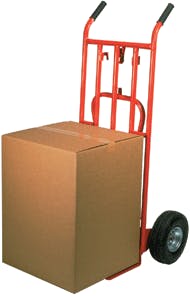By Anne K. Goedken
Are the collaborative workspaces in your facility turning into makeshift offices? Is there a line forming outside the women's washroom? Maybe a new location is necessary for increased visibility. For a company executive, a growing organization is a measure of profitability and success. For facilities professionals, this growth may be cause for stress.
"Statistically, the in-house person who's responsible for the move is most likely to get fired very shortly after the move occurs," says Diane Bashor, president at Overland Park, KS-based FMExtension. To guarantee that this statistic doesn't include you, follow these five steps to lead an organized and successful relocation.
1. Create a Detailed Schedule.
You've been assigned to manage the move process. What next? "It's like eating an elephant," Bashor comments. "You do it a bite at a time."
Detailed scheduling is the first piece in putting together a relocation plan. Depending on the size of the move, your timeline should include lists of what's to be done starting as early as 1 year out and up through the day of the move itself. At 1 year out, the schedule may include items as general as locating new space and estimating associated costs. At 2 weeks out, the timeline should be as specific as possible, instructing employees on how to pack their own office materials. "[The schedule should] break it down step by step to make sure everyone understands exactly what to do, from to how to fill out labels to where to affix them on the crate. The more instructions you give, the smoother the process will go," explains Christine Mosholder, partner at Corporate Project Partners, Boston.
Another crucial step at the beginning of the process: Getting the right internal people on your team. "Whether it's outside resources or internal resources, you really need to assign the right people to the right tasks," Mosholder comments. She recommends creating subgroups made up of internal people who are responsible for specific facets of the move, such as voice and data continuity and communications.
Anticipating scheduling conflicts before they happen can also help you stay on schedule. Knowing that new-furniture shipment and installation has an 8- to 10-week lead time (and inserting that task into the master schedule accordingly) will prevent having to push the move back because of a lack of furniture. Mosholder points out other key components of a move that have long lead times: "Anything related to your communications or your voice and data services - they could have anywhere from 2- to 4-month lead times." She also mentions generators, UPS equipment, and major infrastructure equipment. Being aware of the amount of time it takes to procure and install these types of systems will minimize frustration if things don't go right later.
Closer to the day of the move, the smaller, less-obvious details should dominate your timeline. Three months prior, contact the city to see if any street repairs are planned outside either the current facility or the new location. Also, now's the time to clean out any unnecessary materials. "Get rid of as much waste as possible. Don't take it with you to the new space, stick it in a drawer, and let it sit there for another 15 years," says Brian Bennett, president at Tulsa, OK-based The Facility Group.
At least 1 month prior to the move, check with neighboring buildings about any unusual activities in the area. There may be a farmer's market or a parade that will affect traffic or make parking and unloading difficult. Other potential problems to check into include the placement of loading docks and the availability and size of elevators. Also consider hiring security guards to watch over equipment as it is moved. Notify the police or traffic controllers if your move will affect traffic outside either building.
When's the best time to schedule the move itself? "The obvious answer is weekends, and even better - long weekends. They provide a natural downtime in the business process - if anything happens to go wrong in the move process, you've got a little time to correct it," recommends Steve Fox, partner at Corporate Project Partners.
Countless vendors are needed to assist in relocation; their performance may determine your success. "As much care should be given to [selecting movers] as choosing an architect," Fox claims. "Look at each one of these moving companies' clients and determine if they've moved companies similar to your type [of organization]." Pay attention to references - they should carry even more weight than a vendor's quote in your selection process. "[You should] actually pick up the phone and call references to make sure that [you're] dealing with a company that has moved an organization similar in size and scope," Bennett adds.
Another mistake often made in selecting movers, according to Bennett, is to choose a company that has assisted your facility with smaller-scale projects in the past. Even though you may have an established relationship, they may not have the resources needed for an all-encompassing relocation.
When dealing with all types of vendors, a universal request for proposal (RFP) is essential. "It's really important to use an RFP with all of the pertinent information in one document and stick to it, so that when the [quotes] come in, you have a price for the same thing from each vendor. [That way], you can get an apples-to-apples quote at the end of the process," Bashor says. Without a central document, it may be difficult to keep individual walkthroughs with vendors consistent and accurate.
Corporate relocations take time; keeping that fact in mind will save you stress and money down the road. "A lot of things change in a big organization over that duration, so you have to be flexible," Mosholder comments. "It's [one] of the reasons why people choose very flexible workspaces and layouts, because there are reorganizations, new business initiatives, mergers, and acquisitions - lots of things happen over the course of the project."
Flexibility will help you weather the issues you can't anticipate when planning your relocation. "[We have a] client that is [located] next to an arena. The circus comes to town in November, so there are a couple weekends that we can't have a move because they share the same back streets - where the elephants are," Bashor says.
Communication is important on many different fronts of a relocation. A chain of information flowing internally will keep occupants and tenants in the loop and away from the rumor mill. Bashor recommends appointing department-move coordinators to keep all individuals involved in the move abreast of the timeline and changes. Fox agrees: "It's important for everyone in the company to understand what the move is trying to achieve from a strategic level - what their individual responsibilities are and the timing of those so people feel they're part of the process and, ultimately, part of the solution."
5. Follow Through.
Even with extensive planning, flexibility, communications, and the right vendors, issues may arise as occupants fill their new workstations. Be proactive to make the transition as seamless as possible. Fox recommends having a few movers on hand the day after the move for any necessary rearranging or clean-up. "Those types of tactical tasks [should be] handled on Day One to keep people operational and to save time," he says. In addition to keeping the area free of clutter, clearing the facility of any rented moving supplies (like crates) will save you money. "The [moving] industry has moved toward crates vs. boxes; the quicker [you] can [return them], the better," Fox shares.
Problems can range from missing keys, malfunctioning phones, and lost boxes to an entire computer network being down. Even before occupants enter the building, a punch crew should come through to check all modular-furniture systems for problems. Set up a command center on the first day in the new facility to field occupant concerns. "On Day One, have sign-up sheets for people to [list problems] and have the vendors on-site so that they can get the problem taken care of," Bashor recommends.
The more detailed your planning ahead of time, the less hassle you'll experience during those first few days after the move. In a corporate relocation seminar that Bennett created for the Houston-based Intl. Facility Management Association (IFMA), he carries around a tape of Erin Brockovich to demonstrate what can go wrong. One scene of the movie shows the characters in their new, plush offices after winning a multi-million-dollar judgment. The camera pans the hallway and lands on the receptionist, who cannot figure out how to transfer a call on her high-end telephone. "Maybe the telephone vendor didn't do a real good job on training those folks," guesses Bennett. Anticipating those types of technical issues and counteracting them through communication with vendors will help prevent a scene like that in your new building.
Anne K. Goedken ([email protected]) is new products editor at Buildings magazine.



